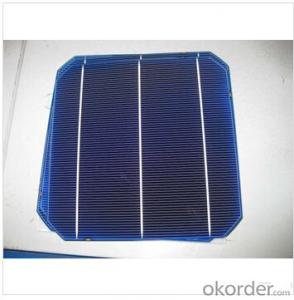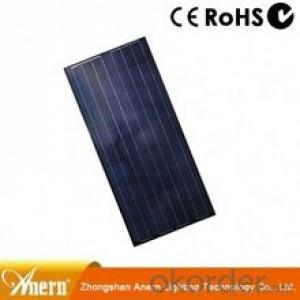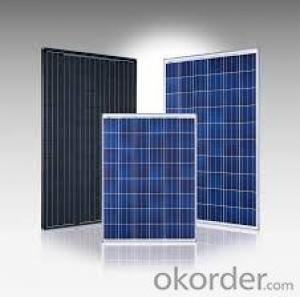Monocrystalline Solar Cells High Quality 156mm×156mm±0.5mm
- Loading Port:
- Shanghai
- Payment Terms:
- TT OR LC
- Min Order Qty:
- 1000 pc
- Supply Capability:
- 1000000 pc/month
OKorder Service Pledge
OKorder Financial Service
You Might Also Like
Solar Cells:
Solar cells is made by solar wafer, it has three categories of solar cell right now, monocrystalline polycrystalline and thin film,These cells are entirely based around the concept PN junction, which is the critical part of solar module, it is the part that can convert the light energy into electricity, the thickness is from 180um to 200um, with even busbars to conduct electricity, textured cell can decrease diffuse reflection; they are often electrically connected and encapsulated as a module. Photovoltaic modules often have a sheet of glass on the front (sun up) side, allowing light to pass while protecting semiconductor wafers from abrasion and impact due to wind-driven debris, rain, hail, etc. Solar cells are also usually connected in series in modules, creating an additive voltage. Connecting cells in parallel will yield a higher current;With high quality and stable quality. Our Cells can greatly improve the performance of Solar Modules.
Features:
1. High conversion efficiencies resulting in superior power output performance.
2. Outstanding power output even in low light or high temperature conditions
3. Optimized design for ease of soldering and lamination
4. Long-term stability, reliability and performance
5. Low breakage rate
6. Color uniformity
Solar Cells Advantage:
• High efficiency and stable performance in photovoltaic conversion.
• Advanced diffusion technique ensuring the homogeneity of energy conversion efficiency of the cell.
• Advanced PECVD film forming, providing a dark blue silicon nitride anti-reflection film of homogenous color and attractive appearance.
• High quality metal paste for back surface and electrode, ensuring good conductivity, high pulling strength and ease of soldering.
• High precision patterning using screen printing, ensuring accurate busbar location for ease with automatic soldering a laser cutting.
Specifications:
Dimension: | 156mm×156mm±0.5mm | |||||||||||
Diagonal: | 220mm±0.5mm | |||||||||||
Thickness(Si): | 200±20 μm | |||||||||||
Front(-) | Blue anti-reflecting coating (silicon nitride); | |||||||||||
1.5mm wide bus bars; | ||||||||||||
Distance between bus bars: 51mm . | ||||||||||||
Back(+) | Aluminum back surface field; | |||||||||||
2.0mm wide soldering pads; | ||||||||||||
Distance between bus bars :51mm . | ||||||||||||
Efficiency(%) | 18 | 17.8 | 17.6 | 17.4 | 17.2 | 16.8 | 16.6 | 16.4 | 16.2 | 16 | 15.8 | 15.6 |
Pmpp(W) | 4.33 | 4.29 | 4.24 | 4.19 | 4.14 | 4.09 | 4.04 | 3.99 | 3.94 | 3.9 | 3.86 | 3.82 |
Umpp(V) | 0.53 | 0.527 | 0.524 | 0.521 | 0.518 | 0.516 | 0.514 | 0.511 | 0.509 | 0.506 | 0.503 | 0.501 |
Impp(A) | 8.159 | 8.126 | 8.081 | 8.035 | 7.99 | 7.938 | 7.876 | 7.813 | 7.754 | 7.698 | 7.642 | 7.586 |
Uoc(V) | 0.633 | 0.631 | 0.628 | 0.625 | 0.623 | 0.62 | 0.618 | 0.617 | 0.615 | 0.613 | 0.611 | 0.609 |
Isc(A) | 8.709 | 8.677 | 8.629 | 8.578 | 8.531 | 8.478 | 8.419 | 8.356 | 8.289 | 8.22 | 8.151 | 8.083 |
Packaging & Delivery of Solar Cells
Carton Box Package and Deliver by air. It should be noticed that it should be avoid of water, sunshine and moist.

FAQ
We have organized several common questions for our clients,may help you sincerely:
①What price for each watt?
It depends on the efficiency of the solar cell, quantity, delivery date and payment terms.
②How long can we receive the product after purchase?
In the purchase of product within three working days, We will arrange the factory delivery as soon as possible. The pecific time of receiving is related to the state and position of customers.Commonly 7 to 10 working days can be served.
③Can you provide the peripheral products of the solar panels, such as the battery, controller, and inverter? If so, can you tell me how do they match each other?
Yes, we can, we have two companies for solar region, one is CNBM International, the other is CNBM engineering Co.
We can provide you not only the solar module but also the off grid solar system, we can also provide you service with on grid plant.
④What is your warranty of solar cell?
Our product can promise lower than 0.3% open box crack, we support claim after opening the box if it has crackm color difference or sth, the buyer should give pictures immediately, we can not accept the claim after the solar cell has assembled to solar panel.
• Timeliness of delivery
• ⑤How do you pack your products?
We have rich experience on how to pack the solar cell to make sure the safety on shipment, we could use wooden box or pallet as buyer's preference.
- Q:How are solar cells manufactured?
- Solar cells are manufactured through a multi-step process that involves the production of silicon wafers, the creation of a p-n junction, the addition of anti-reflective coatings, and the assembly of electrical contacts.
- Q:Can solar cells be used to power remote agricultural monitoring systems?
- Yes, solar cells can be used to power remote agricultural monitoring systems. Solar cells convert sunlight into electricity, providing a sustainable and renewable energy source for powering various electronic devices, including monitoring systems used in agriculture. This enables the monitoring systems to operate independently in remote areas without the need for a constant power supply or grid connection.
- Q:How do solar cells handle power quality issues?
- Solar cells do not directly handle power quality issues. However, inverters, which are an integral part of solar power systems, help mitigate power quality issues. Inverters convert the direct current (DC) produced by solar cells into alternating current (AC) that is suitable for use in electrical systems. Modern inverters include features such as voltage regulation, frequency control, and power factor correction, which help maintain power quality within acceptable limits. Additionally, grid-tied solar systems often rely on the electrical grid to balance power quality issues, as excess solar electricity can be fed back into the grid or drawn from it when needed.
- Q:Can solar cells be used to power electric vehicle charging stations?
- Yes, solar cells can be used to power electric vehicle charging stations. Solar panels can generate electricity from sunlight, which can then be used to charge electric vehicles. This renewable energy source is a sustainable and environmentally friendly option for powering charging stations.
- Q:What is the lifespan of a solar cell?
- The lifespan of a solar cell can vary depending on various factors such as the quality of the materials used, the manufacturing process, and the operating conditions. On average, most solar cells have a lifespan of around 25 to 30 years. However, with proper maintenance and care, some solar cells can continue to produce electricity for even longer periods.
- Q:How do solar cells perform in regions with high levels of salt spray and corrosive environments?
- Solar cells may experience degradation in regions with high levels of salt spray and corrosive environments. The salt particles and corrosive elements can cause the deterioration of the cell's components, such as the protective coatings and metal contacts. This can result in reduced efficiency and lifespan of the solar cells. However, advancements in materials and designs have been made to improve their resistance to corrosion, allowing solar cells to perform relatively well in such challenging environments.
- Q:Can solar cells be used for powering data centers?
- Yes, solar cells can be used for powering data centers. Solar energy can be harnessed through photovoltaic cells and converted into electricity, which can then be used to power data centers. This renewable energy source is increasingly being adopted by data centers to reduce their carbon footprint and energy costs.
- Q:Can solar cells be used in marine applications?
- Yes, solar cells can be used in marine applications. They can be integrated into boats, yachts, and other marine vessels to generate electricity from sunlight, which can be used to power various onboard systems and equipment. Additionally, solar cells can also be used to charge batteries, providing a reliable and sustainable source of energy for marine applications.
- Q:Can solar cells be used in satellites?
- Yes, solar cells can be used in satellites. In fact, they are the primary source of power for most satellites in space. Solar cells convert sunlight into electricity, allowing satellites to generate the energy they need to function and carry out their missions.
- Q:How do solar cells affect the local ecosystem?
- Solar cells have a minimal impact on the local ecosystem. Unlike traditional energy sources, solar cells do not produce harmful emissions or pollution during their operation. Additionally, solar farms can be designed to coexist with the natural environment by incorporating measures like landscaping and wildlife-friendly habitats. Overall, solar cells contribute positively to the local ecosystem by promoting clean energy and reducing carbon emissions.
1. Manufacturer Overview |
|
|---|---|
| Location | |
| Year Established | |
| Annual Output Value | |
| Main Markets | |
| Company Certifications | |
2. Manufacturer Certificates |
|
|---|---|
| a) Certification Name | |
| Range | |
| Reference | |
| Validity Period | |
3. Manufacturer Capability |
|
|---|---|
| a)Trade Capacity | |
| Nearest Port | |
| Export Percentage | |
| No.of Employees in Trade Department | |
| Language Spoken: | |
| b)Factory Information | |
| Factory Size: | |
| No. of Production Lines | |
| Contract Manufacturing | |
| Product Price Range | |
Send your message to us
Monocrystalline Solar Cells High Quality 156mm×156mm±0.5mm
- Loading Port:
- Shanghai
- Payment Terms:
- TT OR LC
- Min Order Qty:
- 1000 pc
- Supply Capability:
- 1000000 pc/month
OKorder Service Pledge
OKorder Financial Service
Similar products
New products
Hot products
Hot Searches
Related keywords


























